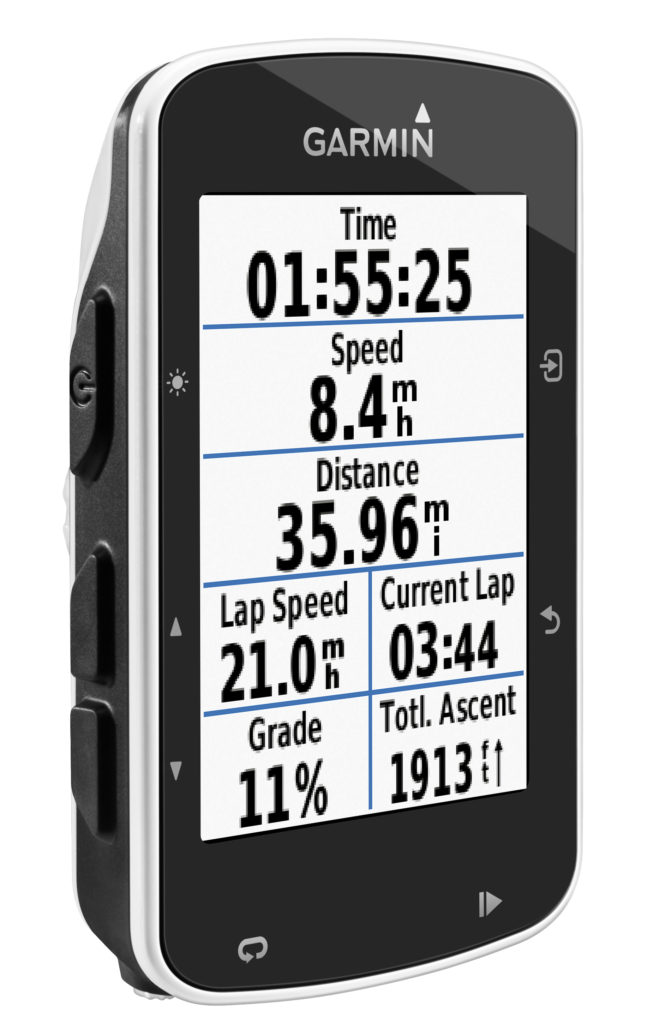Last year after I started racing enduro and saw a few other people using them I researched and ended purchasing a Garmin Edge 520. It’s a device that you attach to your handlebar that tracks distance, speed, elevation, and more data like that. The device is usually used by road bikers, and there are plenty of general overviews and reviews of them out there, but I’m going to be talking more about the MTB use of the device and what I use it for to become fitter and faster.

The device in general is well made, waterproof, and easy to use. I have had to get one replaced because I put it on the front of my seat post on my DH bike, which I hung up on a stand at the Whistler Bike Park and ended up damaging the screen. Fortunately they have a crash replacement deal where you send in your damaged one and for $100 they’ll send you back a refurbished one. A whole lot better than having to buy a brand new device! The screen is definitely the weak point on the device. I have seen many damaged due to relatively low impacts and they do scratch very easily.
There are so many different data fields that you can record and have show up on your screen. You can customize everything and put it where you want it to go as well as individually chose what system of measurement you want each field to display. If you want your distance in Metric and your elevation in Standard, you can do it. I chose to display Distance, Elapsed time, Speed, Time of Day, Temperature, Heart Rate, Calories Burned, Total Accent and Elevation in that order. That isn’t a random choice of data fields, each one is chosen to give me the information I need to make choices in the way I’m riding.
During the EWS race in Chile, they provided the distance, elevation, and elevation gain for each stage and liaison. On the longest one that was the most exposed, I was able to gauge my pace, water, and food because I knew exactly how far away I was and how much further and higher I needed to go before the feed station. Temperature is probably the least important field, I just like bragging about how hot it was during a ride.
You can upload maps to help you get around just by using the device, but I haven’t used that feature yet. I think it would be really useful for road riders who are riding in new areas of town, but I don’t do that often enough to use the feature. You can also do that using Trailforks for mountain bikers. Maybe one day I’ll be surprised and wonder why I haven’t tried it out yet. There are also options to display and record things like Power output, Total Decent, Direction, and others things like that which I’ve tried using, but didn’t see them useful for what I need during racing. Cadence is something that is helpful during training so I can get used to pedaling at a certain speed so that when I’m racing it just comes naturally. Unfortunately the Cadence sensor doesn’t fit on my mountain bike, only my road bike.
Even though I got the device with a Sportchek discount, it wasn’t exactly cheap. The watch I have is able to record Heart Rate, Distance, Speed, and will show you a map of where you went with elevation after you upload it to the app, but I wanted something that I could easily see during a hard ride. Plus the battery wouldn’t last long using the GPS on my watch, where as I’ve never ran out of battery on the Garmin even during 8 hour rides using all the features. The benefits outweighed the cost of the device, in my opinion and I didn’t regret the purchase.
Another reason why I take it on every ride is that it directly records and uploads your ride to Strava where you can compare you times to your previous attempts at the same trail or segment and to other peoples times. Sure you can also use your phone, but during a long ride, using the GPS tracker can really cut down the battery life. Some people make fun of Strava, but as you may have read on my How Strava Helps Me Go Faster post last year, using it can be beneficial.
If you’re a strategic racer/rider like me and like knowing how much further or higher it is to the next feed station during a hot hard race, I would recommend this device. If you like to log your rides, it’s easy to connect the device to Strava and automatically upload your rides so that you can see how fast you were that day without eating through your phone battery. The only problem I have with using the Garmin is that I haven’t quite gotten used to electronics mixing with mountain bikes, and have forgotten it on the charger at home during the EWS race in Columbia. I also had lost it the day before the EWS race in Whistler and definitely could have use the information that it provides to better gauge my effort on the steep liaisons. Those aren’t problems with the device itself, more with the dork who’s trying to use it.

